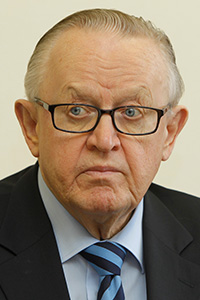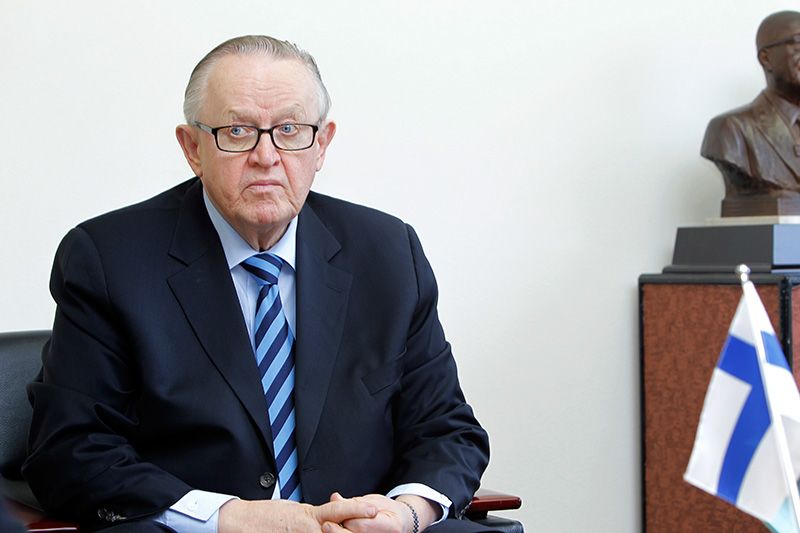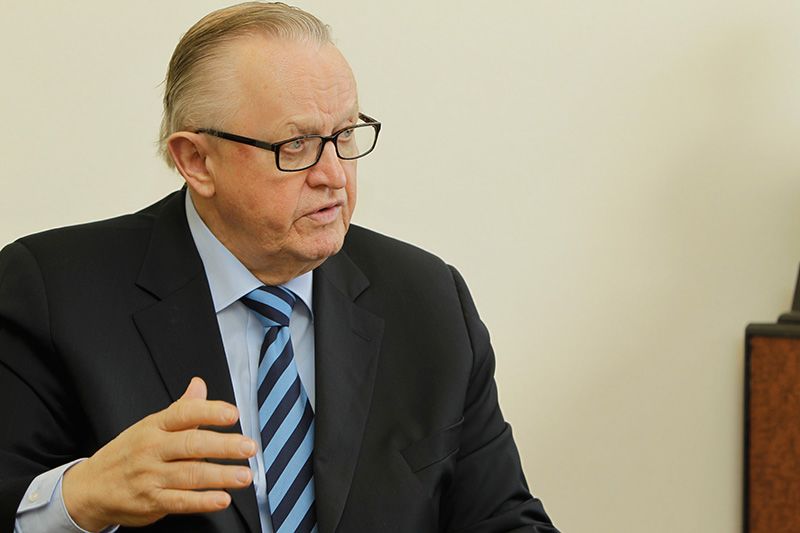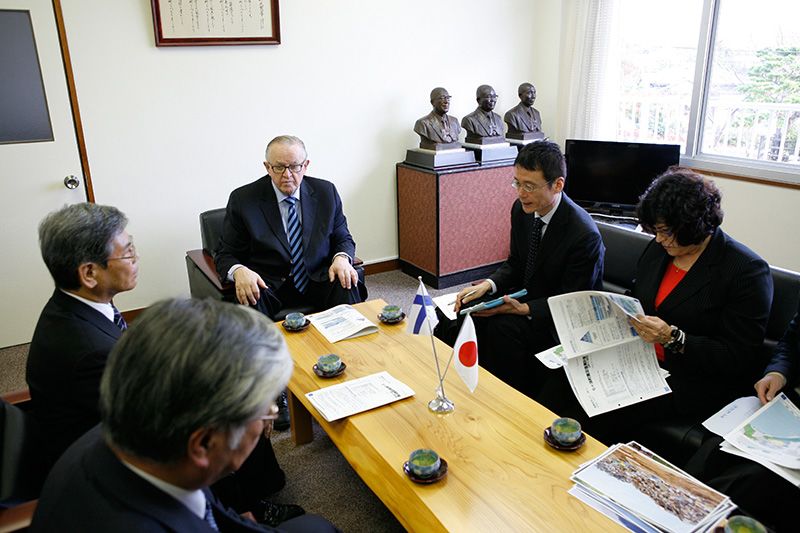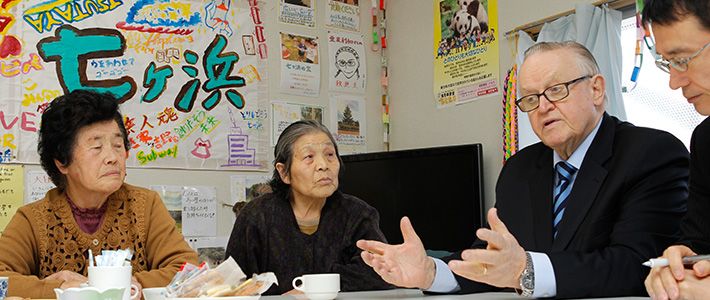
Messages from a Man of Peace
Politics Society- English
- 日本語
- 简体字
- 繁體字
- Français
- Español
- العربية
- Русский
“As a peace mediator I see myself as an honest broker. For me it is important that the negotiating parties know who I am, what I stand for, and where I draw the red lines. This way I can honestly and openly work with the parties toward finding a solution.”
Martti Ahtisaari, former president of Finland and recipient of the 2008 Nobel Peace Prize, described his role thus to a packed hall at Tokyo’s Hotel Okura on November 24, 2011. Invited by the Sasakawa Peace Foundation to give a speech on peace mediation and to conduct a master class on conflict resolution and peacebuilding for specialists and researchers in Japan, Ahtisaari had a full schedule during his short stay in Japan. It was made even fuller by his desire to travel north and see for himself the aftermath of the March 2011 tsunami that devastated coastal Tōhoku. Nippon.com accompanied the Nobel laureate on his tour of Sendai and the town of Shichigahama, Miyagi Prefecture, on Saturday 26.
The Role of the Mediator
The attendees at his November 24 speech had questions for Ahtisaari following his address on broad topics of peace mediation. “Resolution is always possible,” he stated; but what, asked one participant, do you do when a conflict actor brings unworkable demands to the table?
“As an honest broker,” replied Ahtisaari, “the mediator must pass judgment on what is reasonable and what isn’t. When I was working on the Aceh conflict, for example, the Indonesian government wanted GAM [the Free Aceh Movement] to disarm, and this proved possible. In return, however, GAM demanded that the military stick to defense and abandon its policing role, and we had discussion on how many troops to allow in Aceh. While I supported this, I said that so long as the military stuck to its defense functions, the number of troops stationed in Aceh should be a military decision. Turning around again, I also said that local political parties must be allowed, and the government accepted this as well. The mediator has to make these calls.”
While the peace mediator clearly plays an active role, in his speech Ahtisaari stressed that the role is a thankless one at times: “In some cases the mediator may act as the ‘scapegoat’ and take the responsibility for unpopular decisions. . . . It is also of greater benefit to the process that the mediator forgets his or her own ego and lets the parties themselves receive the credit for the achieved agreement, even in situations where they might not have fully deserved it.”
He also emphasized that a negotiated peace settlement does not mean sustainable peace has been achieved, describing it as “only one step on the way . . . just a beginning.” As a beginning, though, noted Ahtisaari, “it can provide the parties with the necessary building blocks to start working toward a peaceful society.”
What Japan Can Do
It is in this area—building on an initial peace agreement and laying the groundwork for revitalization of a peaceful society over the longer term—that Japan plays a valuable role, according to Ahtisaari. “The peace mediator can’t solve everything,” he noted in the question-and-answer session following his Tokyo speech. “The key is to build frameworks for future development. This is what Japan has been supporting.” He singled out the country’s ongoing efforts in South Sudan as particularly worthy of praise. “Working in the areas of infrastructure and logistics like this—there is nothing more important when it comes to creating frameworks for the future development of a society.”
Turning to the question of what individuals can do, he had pointed advice for young people, in Japan and around the world. “If you have needed skills, you should consider joining organizations where they can be put to use.” Information technology and social networking sites have played a tremendous role in the Arab Spring and other recent movements around the world, so skills in those areas are valuable. During our interview in Miyagi, he commented on the value of specialists’ expertise to the nongovernmental organizations that take them on. “There are many people who have served in peacekeeping missions as voluntary members of armed forces. These groups welcome many other professions, too: engineers, mechanics, doctors . . . All these people can be utilized in civilian crisis management.”
More generally, he advised the young people of Japan: “Use your opportunities to travel. Travel is the best way to learn how the world looks and how to use its languages. Read as much as possible so you can justify your opinions with facts, not beliefs.” The international aspect is particularly important to his own organization, the nongovernmental Crisis Management Initiative, whose members hail from more than 20 nations in all.
Despite talk of a dwindling international role for the country, “what Japan does is important,” Ahtisaari stressed. “Getting involved and working with many partners around the world is a good way of launching the activities that need doing. You should work to build bridges. Network with people in each region who have expertise in their fields.” The outcome, he noted, is educational for everyone: “We, too, learn from these partnerships you form, and we benefit from them as you do.”
A Trip to the North
Following the Thursday speech and the master class on Friday, Ahtisaari boarded a shinkansen bullet train north to Sendai on Saturday, November 26. Tōhoku’s largest city had been hit hard by the massive quake and ensuing tsunami on March 11, as had the nearby town of Shichigahama, where the former president met with Mayor Watanabe Yoshio and other town officials for a briefing on the damage and the recovery efforts.
Ahtisaari had some experience dealing with the aftermath of a major tsunami disaster: the Boxing Day earthquake that struck Indonesia in 2004 had impacted his peace mediation work in Aceh. “It happened a week after I had been approached and told I could start negotiating between the Indonesian government and the Free Aceh Movement, whose leaders were living in Stockholm then. When the tsunami happened, it prompted the participants to find a solution more quickly. They understood that they couldn’t help their relatives and friends if we couldn’t achieve peace at our talks in Finland. It’s sad that so many people died, but I have to say that it highlighted the urgency of the matter. Without it we would never have made peace in less than half a year.”
After the 2004 tsunami, the Finnish government asked Ahtisaari to head a commission investigating how well it had responded to the plight of Finnish citizens caught in the Indian Ocean disaster, in particular those vacationing in the Phuket area of Thailand, around 100 of whom were lost. “Our conclusion was that there was nothing anyone could have done for those who died immediately. But it was important to give that message to their relatives. We also looked at how we could have done better in providing health services to survivors who needed medical care in Thailand—how they were transported home, how Finland’s health services provided them with the long-term assistance they needed.”
The 2011 waves that swamped northern Japan called to mind the human impact of the 2004 tsunami. “Therefore, I was anxious to come here as well,” Ahtisaari said. “I wanted to encourage everyone. I was pleased to see people displaying signs that said ‘Never give up!’”
Ahtisaari was confident that the nation would recover from the disaster. “The performance of a country like Japan, which deals with tsunamis from time to time, is superior to many others that must provide assistance after a natural catastrophe. In Aceh, too, the Japanese were among the first to come and help, and they did their jobs extremely well. They were fast, professional.”
The president had praise for Japan’s peacebuilding efforts in recent years as well. “I’m now learning what the Japanese are planning to do in South Sudan, which is extremely important. I originally joined the foreign service to work on the development cooperation side of things. I know that if you can’t get infrastructure working, life won’t return to normal—and that is a disaster. There’s a growing willingness in Japan to participate in peace mediation, and I came this time to see how we can increase our cooperation. I believe one should encourage every country that is so seriously interested in showing this sort of responsibility.”
The Human Touch
While in Shichigahama, Ahtisaari had detailed questions for the mayor, who—along with the chair of the town assembly, also in attendance—had lost his own home to the waves. Mayor Watanabe spelled out the damage with maps of the flooded areas and figures on lives and property lost. Around 30% of Shichigahama was inundated by the tsunami, which smashed some 1,000 homes. Clearing the rubble away was expected to cost some ¥11 billion. As longer-term problems, Watanabe noted the salinization of much of the town’s farmland—a serious issue in Shichigahama, which lacks rivers to wash the salt back out to sea—and a likely decline in population.
The party then left the town office, and the mayor guided Ahtisaari on a tour of the town, including a drive through neighborhoods where only concrete foundations remained to show where people had once lived, followed by visits to a temporary housing facility and a volunteer center.
It was at these last two stops that Ahtisaari became most energetic. He chatted and smiled with young children and elderly Shichigahama citizens who had lost everything in the disaster. He greeted and thanked the volunteers who had come from around Japan to help the residents put their town on the track to recovery.
Here the diplomat, president, and Nobel Prize winner was in his true element: warm, outgoing, and genuine. The honest broker was showing his talent for connecting with people once again.
(Based in part on a November 26, 2011, interview.)
Great East Japan Earthquake diplomacy tsunami Miyagi Martti Ahtisaari Finnish president Nobel Peace Prize Aceh Kosovo peace Mediation disaster aid foreign ministry
